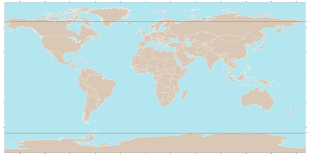Polar circle
Polar circles is called the circles of latitude 66 ° 33 '55 "(≈ 66.57 °) the northern and southern latitude on which the sun on days of the solstice just no longer up or goes down . Their radius corresponds to the axial distance of the tropics from the equator .
The Arctic Circle was already known in ancient Greece : Pytheas reported in the fourth century BC. From the midnight sun , and Eratosthenes wrote about the polar circles a century later. In medieval Europe, the polar circles were drawn on the Cantino Planisphere from 1500.
location
The polar circles limit the polar regions . Its position results from the inclination of the earth's axis in relation to the perpendicular to the ecliptic of currently 23.43 °. The distance between the polar circles and the nearer pole is 2602 km and the equator 7383 km. Its length is 15,996.3 km.
Since the inclination of the earth's axis changes slowly ( obliqueness of the ecliptic ), the polar circles also shift. At the moment they are approaching the poles by about one arc minute in 128 years, or 14.4 meters per year.
In November 2014 , the polar circles were at about 66 ° 33 ′ 55 ″ north or south latitude.
meaning
- Images Arctic Circle
Arctic Circle on the Inland Railway in Sweden
Arctic Circle at the Ore Railway in Sweden
Arctic Circle near Jokkmokk , Sweden
Arctic Circle in the Yukon Territory , Canada
Arctic Circle on the Dalton Highway , Alaska
Arctic Circle on the Egwekinot - Iultin - Mys Schmidta road on Chukotka , Russia
At the Arctic Circle, the sun just doesn't set on the day of the summer solstice . This phenomenon, known as the midnight sun , usually falls on June 21 in the northern hemisphere and on December 21 or 22 in the southern hemisphere . Midsummer Day on June 24 is also associated with celebrations for the summer solstice.
On the day of the winter solstice , the sun is just not rising at the Arctic Circle. That is the day on which the summer solstice is in the other hemisphere .
Because of the refraction of light in the earth's atmosphere (see astronomical refraction ), the phenomenon occurs not only exactly on the polar circle, but also a little further away from the pole (from about ± 65.96 ° latitude) that the sun does not set on one day of the year.
The same applies to the winter solstice. Because of the astronomical refraction, however, you have to be a bit closer to not being able to see the sunrise:
- from about ± 67.16 ° latitude, only half the solar disk comes over the horizon
- from about ± 67.41 ° latitude, not even the upper edge of the sun comes over the horizon. At this point, however, it is light- twilight, like just before sunrise or sunset, because the sun is only just below the horizon.
The closer you get to the pole, the deeper below the horizon the sun is:
- from about ± 73.2 ° latitude, it is always too dark to read the newspaper, because civil twilight is no longer even reached.
- From about ± 79.2 ° latitude, the brightest stars can be seen continuously
- from a latitude of about ± 85.2 °, the sun no longer reaches the location.
While the civilian population in the Arctic Circle and on Svalbard also lives far beyond (over 78 ° north latitude), there is no civilian population near or south of the Arctic Circle. The southernmost civil place on earth , the Argentine Esperanza station , is at 63 ° 23 'south latitude; this corresponds roughly to the proximity of the poles to Trondheim in central Norway .
Polar night and polar day
Areas within the Arctic Circle do not cross the day-night boundary every day . Hence the polar night occurs here , i.e. H. in winter the sun does not rise there for at least one day (longer as the latitude increases).
Half a year later, polar day occurs in the same places : In summer the midnight sun shines for the same number of days, i.e. H. the sun doesn't go down.
In the polar night, however, it does not necessarily stay dark within the polar circles, as other factors have to be taken into account:
- Because of the refraction (refraction of light in the earth's atmosphere), the sun seems to be significantly higher near the horizon than it is in reality, so it can rise completely despite the “theoretical” polar night.
- The sun disk can partially open, it just does not rise completely above the horizon.
- When the sun stays just a little below the horizon, it's twilight . The polar night is therefore nowhere so dark on the European mainland that the stars can be seen continuously.











